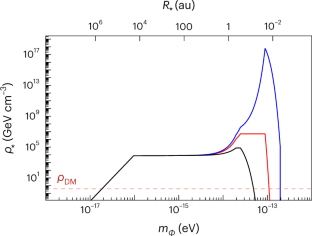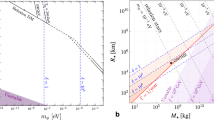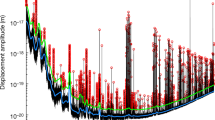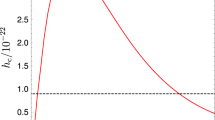Abstract
Recent advances in quantum sensors, including atomic clocks, enable searches for a broad range of dark matter candidates. The question of the dark matter distribution in the Solar system critically affects the reach of dark matter direct detection experiments. Partly motivated by the NASA Deep Space Atomic Clock and the Parker Solar Probe, we show that space quantum sensors present new opportunities for ultralight dark matter searches, especially for dark matter states bound to the Sun. We show that space quantum sensors can probe unexplored parameter space of ultralight dark matter, covering theoretical relaxion targets motivated by naturalness and Higgs mixing. If a two-clock system were able to make measurements on the interior of the solar system, it could probe this highly sensitive region directly and set very strong constraints on the existence of such a bound-state halo in our solar system. We present sensitivity projections for space-based probes of ultralight dark matter, which couples to electron, photon and gluon fields, based on current and future atomic, molecular and nuclear clocks.
This is a preview of subscription content, access via your institution
Access options
Access Nature and 54 other Nature Portfolio journals
Get Nature+, our best-value online-access subscription
$29.99 / 30 days
cancel any time
Subscribe to this journal
Receive 12 digital issues and online access to articles
$119.00 per year
only $9.92 per issue
Buy this article
- Purchase on Springer Link
- Instant access to full article PDF
Prices may be subject to local taxes which are calculated during checkout





Similar content being viewed by others
Data availability
The data that support the plots within this paper and other findings of this study are available from the corresponding author upon reasonable request.
Code availability
The code that generated the plots within this paper and other findings of this study are available from the corresponding author upon reasonable request.
References
Graham, P. W., Kaplan, D. E. & Rajendran, S. Cosmological relaxation of the electroweak scale. Phys. Rev. Lett. 115, 221801 (2015).
Banerjee, A., Kim, H. & Perez, G. Coherent relaxion dark matter. Phys. Rev. D 100, 115026 (2019).
Svrcek, P. & Witten, E. Axions in string theory. J. High Energy Phys. 06, 051 (2006).
Peccei, R. D., Sola, J. & Wetterich, C. Adjusting the cosmological constant dynamically: cosmons and a new force weaker than gravity. Phys. Lett. B 195, 183–190 (1987).
Hu, W., Barkana, R. & Gruzinov, A. Cold and fuzzy dark matter. Phys. Rev. Lett. 85, 1158–1161 (2000).
Ely, T. A., Burt, E. A., Prestage, J. D., Seubert, J. M. & Tjoelker, R. L. Using the deep space atomic clock for navigation and science. IEEE Trans. Ultrason. Ferroelectr. Freq. Control 65, 950–961 (2018).
Puetzfeld, D. & Lämmerzahl, C. (eds) Relativistic Geodesy Vol. 196 (Springer, 2019).
Gozzard, D. R. et al. Ultrastable free-space laser links for a global network of optical atomic clocks. Phys. Rev. Lett. 128, 020801 (2022).
Yin, J. et al. Satellite-based entanglement distribution over 1200 kilometers. Science 356, 1140 (2017).
Burt, E. et al. Demonstration of a trapped-ion atomic clock in space. Nature 595, 43–47 (2021).
Liu, L. et al. In-orbit operation of an atomic clock based on laser-cooled 87Rb atoms. Nat. Commun. 9, 2760 (2018).
Arvanitaki, A., Huang, J. & Van Tilburg, K. Searching for dilaton dark matter with atomic clocks. Phys. Rev. D 91, 015015 (2015).
Van Tilburg, K., Leefer, N., Bougas, L. & Budker, D. Search for ultralight scalar dark matter with atomic spectroscopy. Phys. Rev. Lett. 115, 011802 (2015).
Banerjee, A., Budker, D., Eby, J., Kim, H. & Perez, G. Relaxion stars and their detection via atomic physics. Commun. Phys. 3, 1 (2020).
Flacke, T., Frugiuele, C., Fuchs, E., Gupta, R. S. & Perez, G. Phenomenology of relaxion-Higgs mixing. J. High Energy Phys. 06, 050 (2017).
Craig, N. Naturalness: a snowmass white paper. In 2022 Snowmass Summer Study. Preprint at https://arxiv.org/abs/2205.05708 (2022).
Banerjee, A., Kim, H., Matsedonskyi, O., Perez, G. & Safronova, M. S. Probing the relaxed relaxion at the luminosity and precision frontiers. J. High Energy Phys. 07, 153 (2020).
Maleki, L. & Prestage, J. SpaceTime Mission: clock test of relativity at four solar radii. In Gyros, Clocks, Interferometers...: Testing Relativistic Graviy in Space (Eds Lämmerzahl, C.) 369–380 (Springer, 2001).
Damour, T. & Donoghue, J. F. Phenomenology of the equivalence principle with light scalars. Class. Quant. Grav. 27, 202001 (2010).
Hees, A., Guéna, J., Abgrall, M., Bize, S. & Wolf, P. Searching for an oscillating massive scalar field as a dark matter candidate using atomic hyperfine frequency comparisons. Phys. Rev. Lett. 117, 061301 (2016).
Wcislo, P. et al. New bounds on dark matter coupling from a global network of optical atomic clocks. Sci. Adv. 4, eaau4869 (2018).
Aharony, S. et al. Constraining rapidly oscillating scalar dark matter using dynamic decoupling. Phys. Rev. D 103, 075017 (2021).
Antypas, D. et al. Scalar dark matter in the radio-frequency band: atomic-spectroscopy search results. Phys. Rev. Lett. 123, 141102 (2019).
Kennedy, C. J. et al. Precision metrology meets cosmology: improved constraints on ultralight dark matter from atom-cavity frequency comparisons. Phys. Rev. Lett. 125, 201302 (2020).
Oswald, R. et al. Search for oscillations of fundamental constants using molecular spectroscopy. Phys. Rev. Lett. 129, 031302 (2022)
Bergé, J. et al. MICROSCOPE Mission: first constraints on the violation of the weak equivalence principle by a light scalar dilaton. Phys. Rev. Lett. 120, 141101 (2018).
Wagner, T. A., Schlamminger, S., Gundlach, J. H. & Adelberger, E. G. Torsion-balance tests of the weak equivalence principle. Class. Quant. Grav. 29, 184002 (2012).
Hees, A., Minazzoli, O., Savalle, E., Stadnik, Y. V. & Wolf, P. Violation of the equivalence principle from light scalar dark matter. Phys. Rev. D 98, 064051 (2018).
Tsai, Y.-D., Wu, Y., Vagnozzi, S. & Visinelli, L. Asteroid astrometry as a fifth-force and ultralight dark sector probe. Preprint at https://arxiv.org/abs/2107.04038 (2021).
Veltmaat, J., Schwabe, B. & Niemeyer, J. C. Baryon-driven growth of solitonic cores in fuzzy dark matter halos. Phys. Rev. D 101, 083518 (2020).
Anderson, N. B., Partenheimer, A. & Wiser, T. D. Direct detection signatures of a primordial Solar dark matter halo. Preprint at https://arxiv.org/abs/2007.11016 (2020).
Kaup, D. J. Klein-Gordon Geon. Phys. Rev. 172, 1331–1342 (1968).
Pitjev, N. P. & Pitjeva, E. V. Constraints on dark matter in the solar system. Astron. Lett. 39, 141–149 (2013).
Stadnik, Y. V. & Flambaum, V. V. Enhanced effects of variation of the fundamental constants in laser interferometers and application to dark-matter detection. Phys. Rev. A 93, 063630 (2016).
Ludlow, A. D., Boyd, M. M., Ye, J., Peik, E. & Schmidt, P. O. Optical atomic clocks. Rev. Mod. Phys. 87, 637–701 (2015).
Antypas, D. et al. New horizons: scalar and vector ultralight dark matter. Preprint at https://arxiv.org/abs/2203.14915 (2022).
Safronova, M. S. et al. Search for new physics with atoms and molecules. Rev. Mod. Phys. 90, 025008 (2018).
Kozlov, M. G., Safronova, M. S., Crespo López-Urrutia, J. R. & Schmidt, P. O. Highly charged ions: optical clocks and applications in fundamental physics. Rev. Mod. Phys. 90, 045005 (2018).
Peik, E. et al. Nuclear clocks for testing fundamental physics. Quantum Sci. Technol. 6, 034002 (2021).
Kasper, J. C. et al. Parker solar probe enters the magnetically dominated solar corona. Phys. Rev. Lett. 127, 255101 (2021).
Cavanaugh, J. F. et al. The mercury laser altimeter instrument for the MESSENGER Mission. Space Sci. Rev. 131, 451–479 (2007).
Brewer, S. M. et al. 27Al+ quantum-logic clock with a systematic uncertainty below 10−18. Phys. Rev. Lett. 123, 033201 (2019).
Sanner, C. et al. Optical clock comparison for Lorentz symmetry testing. Nature 567, 204–208 (2019).
Bothwell, T. et al. JILA SrI optical lattice clock with uncertainty of 2.0 × 10−18. Metrologia 56, 065004 (2019).
Hanneke, D., Kuzhan, B. & Lunstad, A. Optical clocks based on molecular vibrations as probes of variation of the proton-to-electron mass ratio. Quantum Sci. Technol. 6, 014005 (2021).
Lange, R. et al. Improved limits for violations of local position invariance from atomic clock comparisons. Phys. Rev. Lett. 126, 011102 (2021).
Leefer, N., Gerhardus, A., Budker, D., Flambaum, V. V. & Stadnik, Y. V. Search for the effect of massive bodies on atomic spectra and constraints on yukawa-type interactions of scalar particles. Phys. Rev. Lett. 117, 271601 (2016).
Derevianko, A. & Pospelov, M. Hunting for topological dark matter with atomic clocks. Nature Phys. 10, 933 (2014).
Dailey, C. et al. Quantum sensor networks as exotic field telescopes for multi-messenger astronomy. Nature Astron. 5, 150–158 (2021).
Stadnik, Y. V. Comment on "Quantum sensor networks as exotic field telescopes for multi-messenger astronomy". Preprint at https://arxiv.org/abs/2111.14351 (2021).
Derevianko, A. et al. Fundamental physics with a state-of-the-art optical clock in space. Quantum Sci. Technol. 7, 044002 (2022).
Banerjee, A. et al. Searching for Earth/Solar axion halos. J. High Energy Phys. 09, 004 (2020).
Flambaum, V. V. & Dzuba, V. A. Search for variation of the fundamental constants in atomic, molecular, and nuclear spectra. Can. J. Phys. 87, 25–33 (2009).
Lange, R. et al. Improved limits for violations of local position invariance from atomic clock comparisons. Phys. Rev. Lett. 126, 011102 (2021).
Safronova, M. S., Porsev, S. G., Sanner, C. & Ye, J. Two clock transitions in neutral Yb for the highest sensitivity to variations of the fine-structure constant. Phys. Rev. Lett. 120, 173001 (2018).
Fadeev, P., Berengut, J. C. & Flambaum, V. V. Sensitivity of 229Th nuclear clock transition to variation of the fine-structure constant. Phys. Rev. A https://doi.org/10.1103/PhysRevA.102.052833 (2020).
Flambaum, V. V. Enhanced effect of temporal variation of the fine structure constant and the strong interaction in Th229. Phys. Rev. Lett. 97, 092502 (2006).
Weyers, S. et al. Advances in the accuracy, stability, and reliability of the PTB primary fountain clocks. Metrologia 55, 789–805 (2018).
Stuhler, J. et al. Opticlock: transportable and easy-to-operate optical single-ion clock. Measurement: Sensors 18, 100264 (2021).
Keller, J., Partner, H. L., Burgermeister, T. & Mehlstäubler, T. E. Precise determination of micromotion for trapped-ion optical clocks. J. Appl. Phys. 118, 104501 (2015).
Bothwell, T. et al. Resolving the gravitational redshift within a millimeter atomic sample. Nature 602, 420–424 (2022).
Leibrandt, D. R., Porsev, S. G., Cheung, C. & Safronova, M. S. Prospects of a thousand-ion Sn2+ Coulomb-crystal clock with sub-10−19 inaccuracy. Preprint at https://arxiv.org/abs/2205.15484 (2022).
Zaheer, M. H., Leibrandt, D., Hume, D. & Safronova, M. S. Quantum metrology algorithms for dark matter searches with 229 Th3+. In 53rd Annual Meeting of the APS Division of Atomic, Molecular and Optical Physics 67, abstr. K05.00005 (2022).
Centers, G. P. et al. Stochastic fluctuations of bosonic dark matter. Nat. Commun. 12, 7321 (2021).
Schioppo, M. et al. Ultrastable optical clock with two cold-atom ensembles. Nat. Photon. 11, 48–52 (2016).
Bothwell, T. et al. Resolving the gravitational redshift within a millimeter atomic sample. Nature 602, 420–424 (2022).
Vermeulen, S. M. et al. Direct limits for scalar field dark matter from a gravitational-wave detector. Nature 600, 424–428 (2021).
Acknowledgements
We thank K. Abazajian, A. Cooray, C. Chen, J. Feng, M. Kaplinghat, H. Kim, D. Leibrandt, G. Perez, S. Profumo and T. Tait for useful discussions. We also thank A. Case and P. Whittlesey for the detailed discussions of instrumentation and environments in space missions, especially the solar probes. We thank D. Budker, Y. Stadnik, P. Thirolf and N. Yu for comments on the manuscript. The work of Y.-D.T. is supported in part by NSF Grant PHY-2210283 and in part by Simons Foundation Grant No. 623683. Part of this document was prepared by Y.-D.T. using the resources of the Fermi National Accelerator Laboratory (Fermilab), a US Department of Energy, Office of Science, HEP User Facility. Fermilab is managed by Fermi Research Alliance, LLC (FRA), acting under contract No. DE-AC02-07CH11359. The work of J. E. was supported by the World Premier International Research Center Initiative (WPI), MEXT, Japan, and by the Japanese Society for the Promotion of Science KAKENHI grant Nos. 21H05451 and 21K20366. This work is supported in part by US NSF grants Nos. PHY-2012068 and OMA-2016244. This work is a part of the ‘Thorium Nuclear Clock’ project that has received funding from the European Research Council (ERC) under the European Union’s Horizon 2020 research and innovation programme (grant agreement No. 856415). Part of this work was performed at the Aspen Center for Physics, which is supported by the National Science Foundation grant no. PHY-1607611. We also thank the Simons Foundation for its generous support. J. E. thanks the Galileo Galilei Institute for Theoretical Physics for hospitality and the Istituto Nazionale Fisica Nuclear for partial support during the completion of this work.
Author information
Authors and Affiliations
Contributions
All authors contributed to the writing and reviewing of the manuscript. Y.-D.T. conceived the preliminary ideas, initiated the DM study and studied further applications of space quantum clocks (including the spatial variation of fundamental constants and future applications) while cross-checking all results. J.E. analysed the properties of SHs and produced the final figures used in the manuscript. M.S.S. provided expertise on clock technologies and related sensitivity estimates.
Corresponding authors
Ethics declarations
Competing interests
The authors declare no competing interests.
Peer review
Peer review information
Nature Astronomy thanks the anonymous reviewers for their contribution to the peer review of this work
Additional information
Publisher’s note Springer Nature remains neutral with regard to jurisdictional claims in published maps and institutional affiliations.
Supplementary information
Supplementary Information
Supplementary discussion sections (RELATED STUDIES IN ULDM, CLOCKS IN EARTH ORBITS AND AN EARTH-BOUND HALO), Supplementary Figure S1.
Rights and permissions
Springer Nature or its licensor (e.g. a society or other partner) holds exclusive rights to this article under a publishing agreement with the author(s) or other rightsholder(s); author self-archiving of the accepted manuscript version of this article is solely governed by the terms of such publishing agreement and applicable law.
About this article
Cite this article
Tsai, YD., Eby, J. & Safronova, M.S. Direct detection of ultralight dark matter bound to the Sun with space quantum sensors. Nat Astron 7, 113–121 (2023). https://doi.org/10.1038/s41550-022-01833-6
Received:
Accepted:
Published:
Issue Date:
DOI: https://doi.org/10.1038/s41550-022-01833-6
This article is cited by
-
Advancements in Quantum Optics: Harnessing the Power of Photons for Next-Generation Technologies
Journal of Optics (2023)
-
The phenomenology of quadratically coupled ultra light dark matter
Journal of High Energy Physics (2023)
-
Cosmologically varying kinetic mixing
Journal of High Energy Physics (2023)



